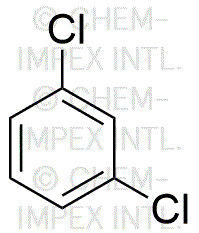1,3-Dichlorobenzene is widely utilized in research focused on:
- Solvent in Organic Synthesis: It serves as an effective solvent for various organic reactions, facilitating the dissolution of reactants and improving reaction yields.
- Intermediate in Chemical Manufacturing: This compound is crucial in producing agrochemicals and pharmaceuticals, acting as a building block for more complex molecules.
- Industrial Degreasing Agent: Its strong solvent properties make it ideal for cleaning and degreasing metal parts in automotive and machinery industries, enhancing equipment maintenance.
- Research in Environmental Studies: It is used in studies assessing environmental contamination, helping researchers understand the behavior and impact of chlorinated compounds in ecosystems.
- Analytical Chemistry: Employed as a standard in chromatography, it aids in the identification and quantification of other compounds, streamlining laboratory analyses.
General Information
Properties
Safety and Regulations
Applications
1,3-Dichlorobenzene is widely utilized in research focused on:
- Solvent in Organic Synthesis: It serves as an effective solvent for various organic reactions, facilitating the dissolution of reactants and improving reaction yields.
- Intermediate in Chemical Manufacturing: This compound is crucial in producing agrochemicals and pharmaceuticals, acting as a building block for more complex molecules.
- Industrial Degreasing Agent: Its strong solvent properties make it ideal for cleaning and degreasing metal parts in automotive and machinery industries, enhancing equipment maintenance.
- Research in Environmental Studies: It is used in studies assessing environmental contamination, helping researchers understand the behavior and impact of chlorinated compounds in ecosystems.
- Analytical Chemistry: Employed as a standard in chromatography, it aids in the identification and quantification of other compounds, streamlining laboratory analyses.
Documents
Safety Data Sheets (SDS)
The SDS provides comprehensive safety information on handling, storage, and disposal of the product.
Product Specification (PS)
The PS provides a comprehensive breakdown of the product’s properties, including chemical composition, physical state, purity, and storage requirements. It also details acceptable quality ranges and the product's intended applications.
Certificates of Analysis (COA)
Search for Certificates of Analysis (COA) by entering the products Lot Number. Lot and Batch Numbers can be found on a product’s label following the words ‘Lot’ or ‘Batch’.
*Catalog Number
*Lot Number
Certificates Of Origin (COO)
This COO confirms the country where the product was manufactured, and also details the materials and components used in it and whether it is derived from natural, synthetic, or other specific sources. This certificate may be required for customs, trade, and regulatory compliance.
*Catalog Number
*Lot Number
Safety Data Sheets (SDS)
The SDS provides comprehensive safety information on handling, storage, and disposal of the product.
DownloadProduct Specification (PS)
The PS provides a comprehensive breakdown of the product’s properties, including chemical composition, physical state, purity, and storage requirements. It also details acceptable quality ranges and the product's intended applications.
DownloadCertificates of Analysis (COA)
Search for Certificates of Analysis (COA) by entering the products Lot Number. Lot and Batch Numbers can be found on a product’s label following the words ‘Lot’ or ‘Batch’.
*Catalog Number
*Lot Number
Certificates Of Origin (COO)
This COO confirms the country where the product was manufactured, and also details the materials and components used in it and whether it is derived from natural, synthetic, or other specific sources. This certificate may be required for customs, trade, and regulatory compliance.


